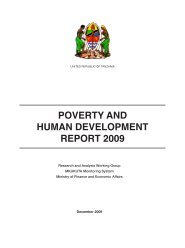Download PDF (4.08 MB) - ReliefWeb
Download PDF (4.08 MB) - ReliefWeb
Download PDF (4.08 MB) - ReliefWeb
You also want an ePaper? Increase the reach of your titles
YUMPU automatically turns print PDFs into web optimized ePapers that Google loves.
105<br />
• Engaging men and boys is important both so that programming can address their<br />
particular needs and concerns and so that these men and boys can become champions<br />
of gender equality.<br />
Promoting women’s economic empowerment. Post-crisis situations create opportunities<br />
for social transformation, including the empowerment of women. Ensuring that<br />
women have better access to and control over livelihood assets is central to progress in this<br />
direction. Key livelihood assets for women’s empowerment include skills and education,<br />
health and nutrition, information, technology, basic infrastructure, natural resources, and<br />
financial services. Focusing on three core dimensions of women’s economic empowerment<br />
can enhance the effectiveness of livelihoods and economic recovery programming<br />
in this area: 60<br />
1) Economic opportunity (e.g., expanding employment and entrepreneurship, prioritizing<br />
domestic energy recovery and development, promoting decent and productive<br />
work, and improving access to finance and markets)<br />
2) Legal status and rights (e.g., enabling women to claim their rights to property, inheritance,<br />
and land and to have improved conditions of employment)<br />
3) Voice, inclusion and participation (e.g., developing mechanisms to enhance women’s<br />
involvement in decision-making bodies).<br />
Improving women’s access to the labour market is especially important. Women’s participation<br />
in the labour market contributes to pro-poor growth, 61 and earning an income can<br />
increase a woman’s role in household decision-making. Interventions that aim to promote<br />
the economic empowerment of women should draw upon the existing knowledge, skills,<br />
and economic activities of both women and men. Areas of intervention that have been<br />
successful in this regard in crisis and post-crisis situations include the following:<br />
• Value chain analysis with a gender lens to illuminate the goods and services where<br />
women are already involved or could be involved<br />
• Support for childcare services and security mechanisms in crisis-affected communities<br />
and at vocational training facilities or workplaces<br />
• Facilitation of women’s access to microfinance<br />
• Promotion of women’s groups and support for the development of their organizational<br />
and advocacy skills<br />
• Awareness-raising activities that promote positive female role models and dispel<br />
negative stereotypes.<br />
The table below provides indicative outputs, indicators, and activities for a hypothetical<br />
programme or project to enhance women’s economic empowerment in a crisis or<br />
post-crisis situation. Intended outputs and activities are always tailored to the particular<br />
context. Annual targets also need to be defined.<br />
60 See UNDP. Innovative Approaches to Promoting<br />
Women’s Economic Empowerment. Paper for the<br />
partnership event on September 25, 2008: MDG3<br />
– Gender Equality and Empowerment of Women<br />
– A Prerequisite for Achieving all MDGs by 2015.<br />
2008.<br />
61 Costa, J & Silva E. (2008). Eliminating gender<br />
inequalities reduces poverty. International Poverty<br />
Centre, Brasilia DF, Brazil.<br />
Livelihoods & Economic Recovery in Crisis Situations





